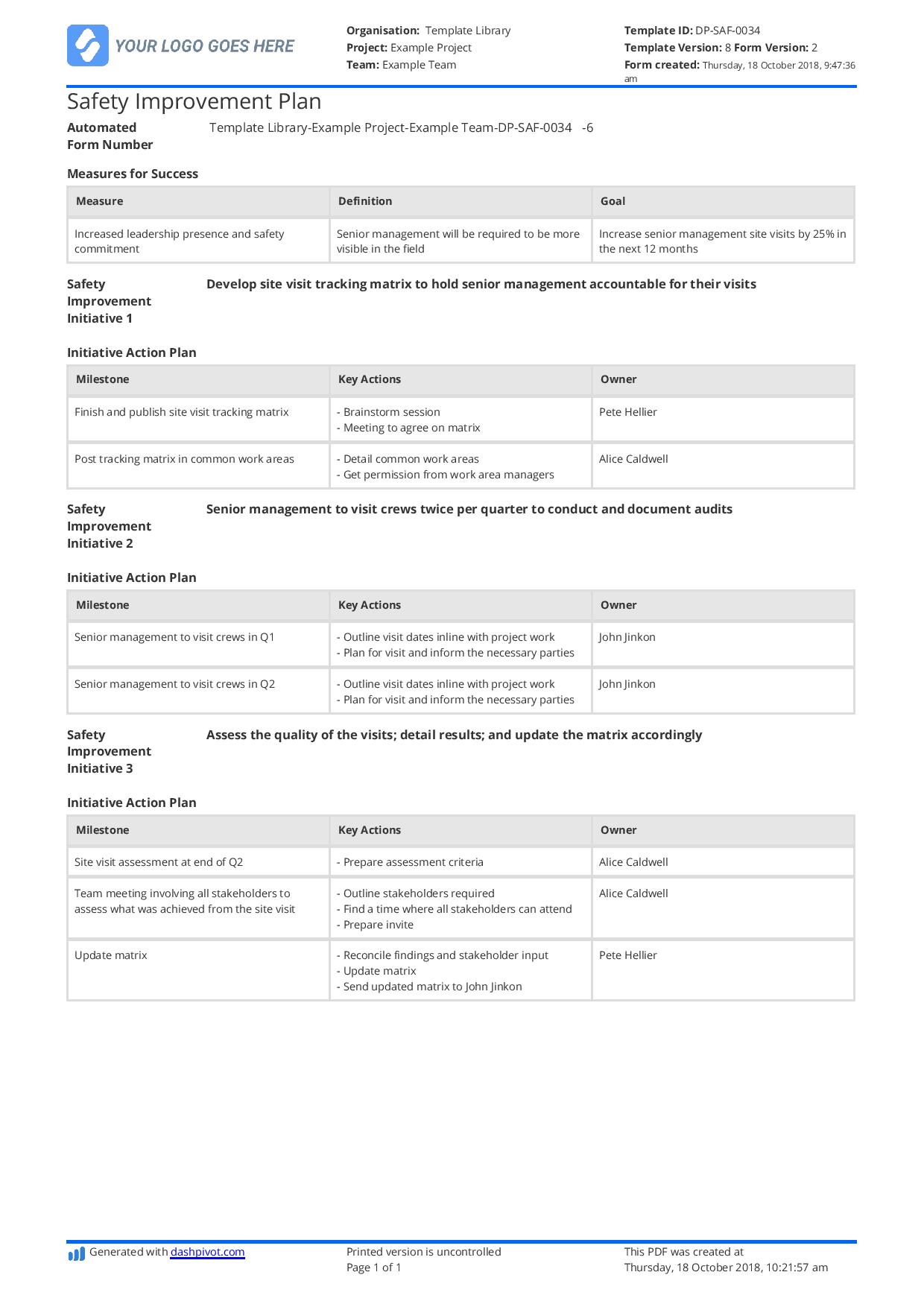Dashpivot article – Health and Safety Plan OSHA
Health and Safety Plan OSHA
Health and Safety Plans (HASP) that comply with OSHA help companies manage hazards effectively. In this article, you will learn the key elements OSHA provided to establish a Health and Safety Plan.

Table of Contents
Article Summary
- A Safety Improvement Plan helps establishments keep their Health and Safety Plans up-to-date and periodically evaluated if changes are made in the process or environment.
- OSHA has provided the following elements to guide workers in making a compliant and effective Health and Safety Plan: management leadership, worker participation, hazard identification and prevention, training, safety improvement, and established communication.
- The Health and Safety Plan evaluates every relocation and assignment of employees. In this review, companies identify all activity and environmental risks so they may take the right steps to eradicate them.
Why are Health and Safety Plans essential?
A Health and Safety Plan (HASP) is important because it evaluates every move an employee makes and every assignment they receive and identifies all existing hazards present in them to implement appropriate measures for eliminating those dangers. Moreover, incorporating a safety improvement plan guarantees the regular updating and field implementation of the health and safety plan, ensuring its continuous effectiveness.
According to OSHA, the main goal of Health and Safety Plans is to prevent workplace injuries, illnesses, and deaths, as well as the suffering and financial hardship these events can cause for workers, their families, and employers. If you want to read more about this, visit OSHA's recommended practices for Health and Safety Plans
Any industry that operates today is continuously progressing because it has healthy and well-cared-for employees. An employee is the most valuable asset that a company has. Employees perform the tasks that enable companies to generate income, which in turn supports their ongoing progress in market ventures. Implementing the health and safety plan in your establishment can ensure that your most valuable assets are well protected. Such measures will be key to your business success, as a healthy employee contributes to a prosperous company.
How can we best format a Safety Improvement Plan?
A Safety Improvement Plan is vital for the Health and Safety Plan because it needs constant updates. This is because of the unavoidable changes in work settings and procedures. When creating a Safety Improvement Plan, the new measures you provide should be based on the hazard assessment conducted on the new procedure or environment, and should also include definitions and objectives.
Next, you should create the necessary action plan to achieve the new measures. You could divide the action plan into milestones to make the action items easily achievable. This approach maintains a procedural structure, streamlining the process of making a new and effective Health and Safety Plan. Visit the example format below for a clearer understanding of this process.

Use this H&S Plan to help with OSHA
How to make an OSHA-compliant Health and Safety Plan?
OSHA has established seven important key elements that companies should provide when creating an effective and compliant Health and Safety Plan for their company. The key elements are
Management Commitment and Leadership
The management should start the process of making the Health and Safety Plan. This demonstrates their commitment and responsibility to ensuring the health and safety of each and every employee. The management needs to establish the objectives and goals in the Health and Safety Plan that are applicable company-wide. These objectives and goals serve as the foundation for developing the relevant policies, programs, and procedures in the Health and Safety Plan. Furthermore, the management should clearly define the roles and responsibilities of each manager, leader, and member of the establishment. This step is essential because it marks accountability, which drives the continuous implementation of the Health and Safety.
Worker Participation
The involvement of the workers is highly important. They serve as the company's primary observers, actively participating in its processes and tasks. Their inputs would be highly valuable in creating the Health and Safety Plan. Their experience could provide the plan a more rigid structure for preventing hazards in the workplace. Furthermore, acknowledging their input helps them acknowledge their value and worth in the company, which can build encouragement to speak out and report unidentified hazards in the future. Such input helps with the continuous development of the Health and Safety Plan.
Hazard Identification
This key element is the most crucial of all. If companies overlook or inadequately address potential hazards, it can lead to accidents, diseases, and injuries in the workplace. Establishments must take the time to evaluate all of the potential dangers in the workplace, both current and prospective. It is also important to note that it is better to take a systematic approach in identifying the hazards. Observing activities, checking your facilities, and talking to staff may help you detect risks and dangerous circumstances. Scheduling frequent inspections of the workplace to identify hazards will also eliminate any health and safety risks.
Hazard Prevention and Controls
After identifying and evaluating the risks, the next step involves selecting and implementing the appropriate controls. When deciding which controls to implement, keep the "hierarchy of controls" in mind.
The hierarchy of controls is a tool for understanding and rank control methods. Methods at the top of the hierarchy are generally more effective than those at the bottom. The hierarchy is as follows: elimination, substitution, engineering controls, administrative controls, and provision of PPE.
Companies should also practice obtaining employees' opinions on the effectiveness and drawbacks of current safety controls. This could help with planning for alternatives and potential enhancements as you brainstorm them. Because of their close proximity to the risks and controls while working, workers often have the best understanding of them.
Education and Training
The provision of education and training can help make the plan become ingrained in the culture of the workplace rather than being soon forgotten. To ensure the implementation of the program, each and every worker must have a comprehensive understanding of the structure, plans, and processes of the Health and Safety Plan. Workers will then be able to better grasp the objectives behind a Health and Safety Plan, know how it benefits them, comprehend their roles and duties, and discover how they may participate in the development, implementation, and improvement of the program.
Safety Improvement Assessments
A safety improvement assessment assists you in evaluating how effective your Health and Safety Plan is and in determining whether it is on track to meet your objectives. This makes sure to continuously update procedures that are not effective to repel hazards. These continuous updates can enhance the effectiveness of the plan in ensuring a healthy and safe workplace.
Communication and Coordination
Today, many companies use contractors and temporary labor. These are individuals who have been employed by one company to work for another company (the "host" employer). To safeguard all employees in these circumstances, all companies must coordinate and communicate effectively. To ensure that workers are being protected, all employees on a site should be informed of the risks present and the steps required to reduce their exposure.
Who are involved in making the Health and Safety Plan?
Making the Health and Safety Plan is not a one-man job. It requires a collaboration of different heads to create an effective and compliant Health and Safety Plan. In this section, we will discuss the individuals who are vital in creating the Health and Safety Plan.
Management
The management should display their leadership and commitment in making the Health and Safety Plan. It is their responsibility to initiate the plan and provide the scope and company-wide objectives. They are also greatly responsible for allocating resources for the implementation of the control measures needed. They must ensure the plan remains active throughout its implementation and address any arising issues that necessitate its updating.
Safety Officers
Safety officers are professionals who are experts in identifying and controlling hazards in the workplace. Their input in the Health and Safety Plan is vital, especially when identifying hazards and control measures in the work environment. As experts in the safety and health field, they are also responsible for conducting training sessions, performing internal audits, and developing emergency procedures in the workplace, all of which are necessary for an effective health and safety plan.
Industrial Hygenists
A hygienist evaluates workplace and environmental risks using scientific studies, then creates and implements plans to reduce or eliminate worker dangers. To enhance workplace procedures, protocols, and safety, some focus more on risk management and reparatory interventions, while others concentrate more on hazard anticipation and preparedness.
Supervisors/Foremen
These are the personnel who take charge in implementing the Health and Safety Plan. They make sure that all their personnel are practicing the correct procedures cited in the Health and Safety Plan. These are also the personnel who can assess the effectiveness of the plan. They will address any raised concerns and propose necessary changes to management for a more effective plan.
Medical Personnel
Health conservation is one of the goals of a health and safety plan. Including a medical expert in making the plan can establish a health program where every employee's health is monitored. They can also assist in identifying substances that can harm the human body and handle the treatment and first-aid procedures in case of an emergency.
Frontliners/Workforce
The frontliners, or workforce, are the executors of all written procedures in the plan. They directly experience whether the provided plan is sufficient to protect them from the identified hazards in the field. Having said this, their inputs are vital to the continuous improvement of the plan.
Staying OSHA compliant with a smart Health and Safety Plan
Paper-based Health and Safety Plan forms can be quite tedious to complete. Furthermore, errors are statistically high on these paper-based forms due to the multiple processes involved. Having errors on a document that is crucial for worker safety would undermine the entire purpose of the plan's creation. Furthermore, creating and submitting a paper-based form requires a substantial amount of time, which can delay the solutions and measures needed to safeguard the employees.
Summary of Health and Safety Plan OSHA
The goal of a Health and Safety Plan is to provide employees in an establishment with a safe and healthy workplace. To establish an effective plan, companies must follow the elements provided by OSHA. These elements that OSHA has provided will serve as a guideline on how establishments should complete their HASP. Furthermore, incorporating a safety improvement plan will ensure that the HASP will be continuously updated, especially if there are changes in the work procedures and environment. Having a solid and structured plan clearly puts you on the path of consistently achieving your objectives while always staying at optimal efficiency and safety.
Frequently Asked Questions
Is the Health and Safety Plan required in all industries ?
Yes - different companies from different industries need to comply in making a Health and Safety Plan. However, these Health and Safety Plan may differ due to the different requirements for each specific industry.
How is technology changing how people make their health and safety plan?
Technology is transforming the process of completing a Health and Safety Plan by replacing the traditional paper forms with digital solutions like Dashpivot. Teams can now complete tasks faster, automate steps, and streamline compliance. This leads to time savings, better data, and safer worksites.
Does Sitemate provide other forms needed in the Health and Safety Plan?
Yes - Sitemate offers ready-to-use and editable templates that can also be edited for your workflow. Companies of all sizes in every industry are using these Hazard Report Templates right now to streamline their process of documenting potential hazards to provide basis in making their Health and Safety Plans
Related resources

Safe Work Procedure
Keep people following safe every day work procedures, with ease.

Site Specific Induction
Speed up your site induction process to keep people and projects moving forward quickly - and in an organised manner.

Weekly Safety Inspection Checklist
Get your weekly safety inspections done easier and faster, and then keep them all organised and easily searchable.